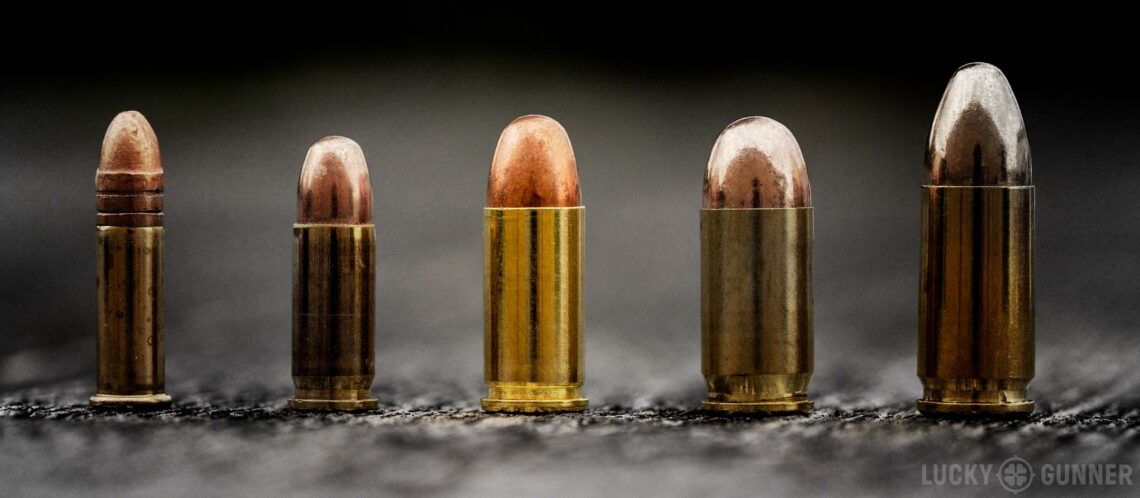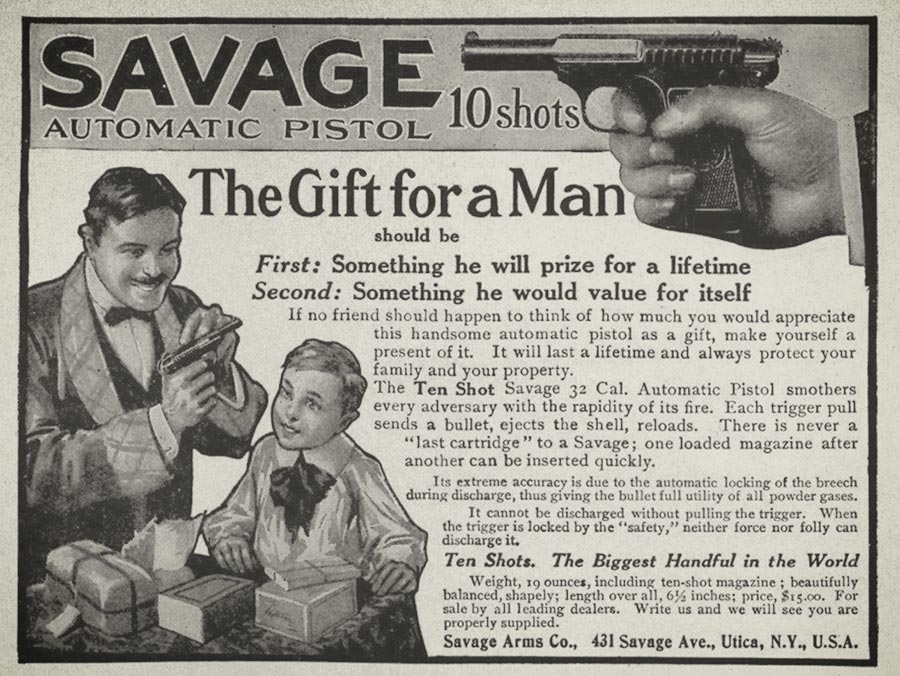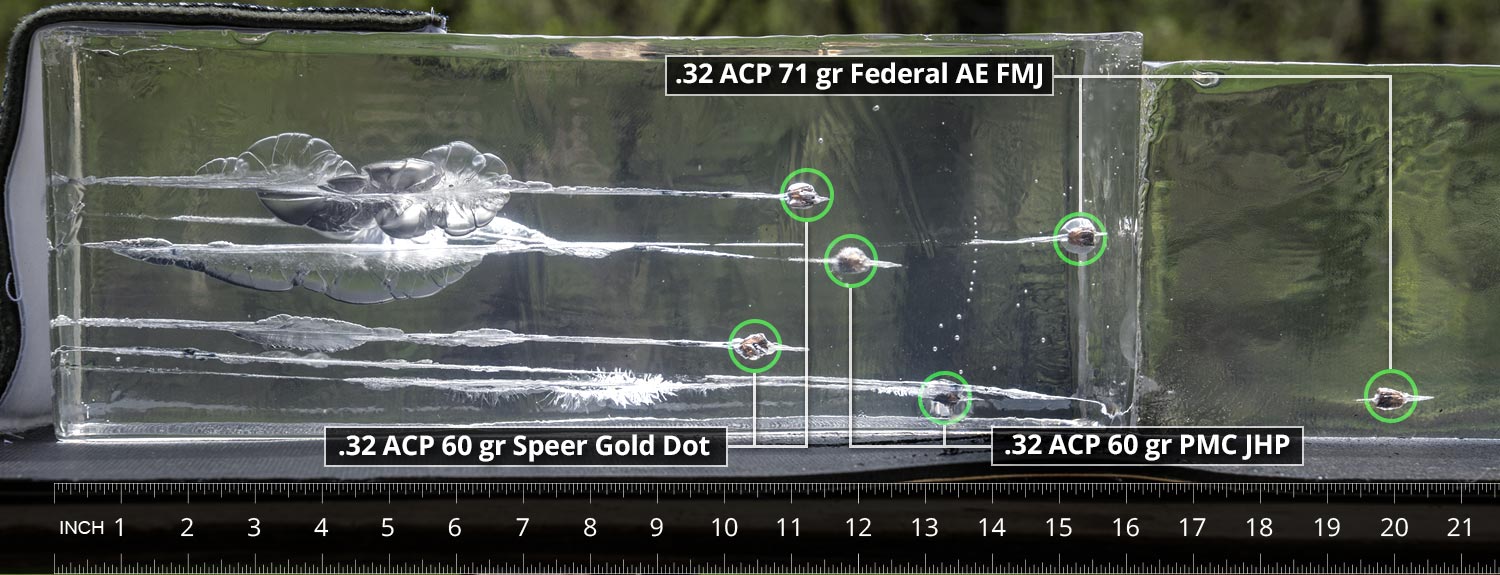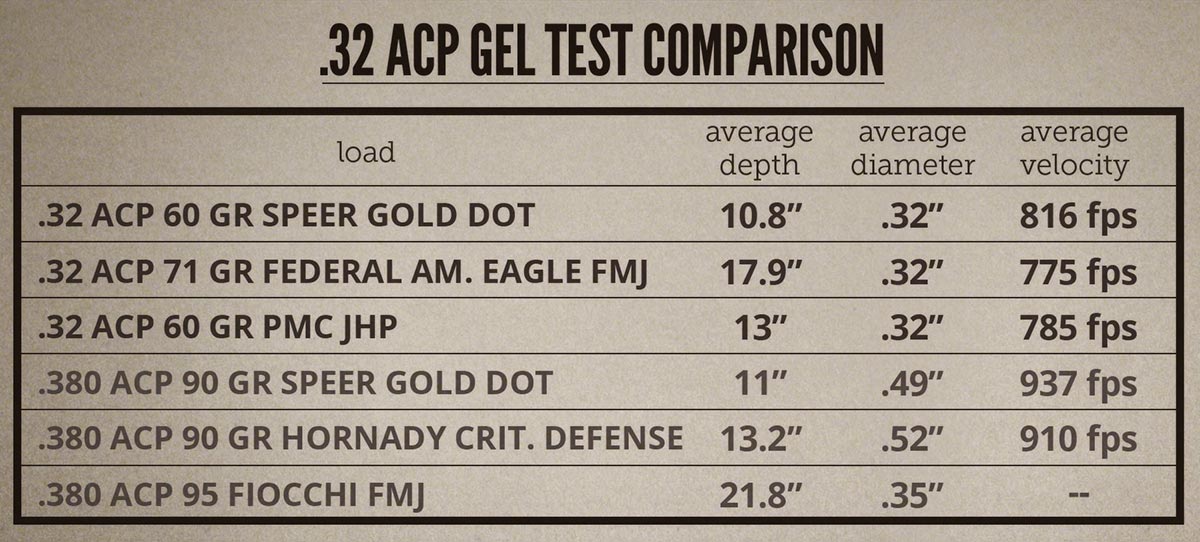If you’ve been following our Pocket Pistols series, you might have noticed a recurring theme: these so-called “mouse gun” calibers are not nearly as useless as the prevailing wisdom suggests. .32 ACP is no exception. While it’s fallen out of favor in recent years, even in a pocket pistol role, .32 ACP offers a clear benefit in reduced recoil (allowing quicker and more accurate shooting) over the more popular .380 ACP while the reduction in ballistic effectiveness is minimal.
In this overview of .32 ACP as a self-defense caliber, we’re taking a quick look at its history, range performance, ballistic gel testing, and modern pocket pistols chambered for this caliber. Details in the video below, or scroll down to read the full transcript.
One hundred years ago, .32 ACP was quite possibly the most popular semi-automatic pistol cartridge in the world. It was developed by John Browning for the FN Model 1900 which was the first ever production pistol to feature a reciprocating slide. .32 ACP quickly caught on, especially in Europe where it is typically known as 7.65 Browning. During the first half of the 20th century, .32 caliber pistols were among the most common sidearms for police and military in Europe. Here in the US, we used larger caliber handguns in those roles, but compact .32 pistols were still successfully marketed to civilians for self-defense.
Semi-autos like the Savage Model 1907 and the Colt 1903 Pocket Hammerless were some of the most common pocket guns. They were much larger than what we think of as a pocket pistol today — they were more like coat pocket pistols — but that was still considered small by early 1900s standards. It’s easy to see the appeal of these old .32s. It’s a light recoiling cartridge and when you load it in a steel framed pistol with a single action trigger, it’s incredibly easy to shoot.
Despite that appeal, the popularity of .32 ACP gradually declined in the second half of the 1900s and that’s a trend that continues today. Pocket pistols are still big sellers, but now .380 ACP is by far the dominant cartridge. According to the ATF, in 2007, there was roughly one .32 ACP pistol made in the US for every three pistols chambered for .380. Since then, the popularity of .380 has exploded while .32 has dwindled to almost nothing. In 2017, for every .32 caliber pistol made, there were 100 .380s.
Almost every major firearms manufacturer now offers at least one .380 pocket pistol. Only two of them still make one for .32 ACP: The Kel Tec P32 and the Beretta 3032 Tomcat. There are also a couple of .32 offered by smaller companies like the North American Arms Guardian and the Seecamp LWS. There might be some others, but if you’re thinking about carrying a .32 ACP pocket pistol that’s in current production, it’s mostly likely one of the four I just mentioned.
I’ve spent some time lately shooting the Kel-Tec P32 and the NAA Guardian. I’ve handled the other two but I don’t have any range time with them.
Beretta 3032 Tomcat
The Beretta Tomcat is essentially a .32 caliber version of the Bobcat 21A. So it’s a double action/single action with the tip-up barrel feature. They’ve been around since the mid-1990s. There were problems with the slides cracking on the early guns. Beretta beefed up the slides, which seemed to fix the problem, but now they’re just kinda wide and heavy for a gun this small. They’re almost twice the width of the KelTec and weigh half a pound more. They might be good shooters, but I think most people are going to find them to be too heavy by modern pocket pistol standards.
Seecamp LWS
The Seecamp LWS is another somewhat older design but it’s slimmer and lighter than the Tomcat. In the 80s and 90s, Seecamp was making the smallest guns you could buy and they made some innovations that kind of paved the way for the modern micro pistol. Just from handling one, my biggest gripe with the Seecamp is that it has no sights. Not even bad ones, just no sights at all. I know a lot of people still believe a small gun like this doesn’t need sights. But it is 2019. The efficacy of training with sights and using them in real shootings when necessary has been well documented. There is no good reason for a modern handgun to omit them completely.
North American Arms Guardian
The NAA Guardian shares some superficial similarities with the Seecamp pistols, although it is slightly larger and heavier. It’s a double action only design with a stainless steel slide and frame which makes it feel dense compared to a polymer framed pistol. Despite that, it’s not a very fun pistol to shoot, at least not for me. The ergonomics are just… off somehow. The tang of the grip is very low on the frame and that gives it an unusually high bore-axis. The trigger pull is very long and heavy. It’s not particularly reliable. It does have sights, but they are very small. You can pay NAA to cut dovetails into the top of the gun and install real sights, so that’s one benefit of this model. But overall, based on my experience with this one, the Guardian combines just about all of the worst attributes a pocket pistol can have.
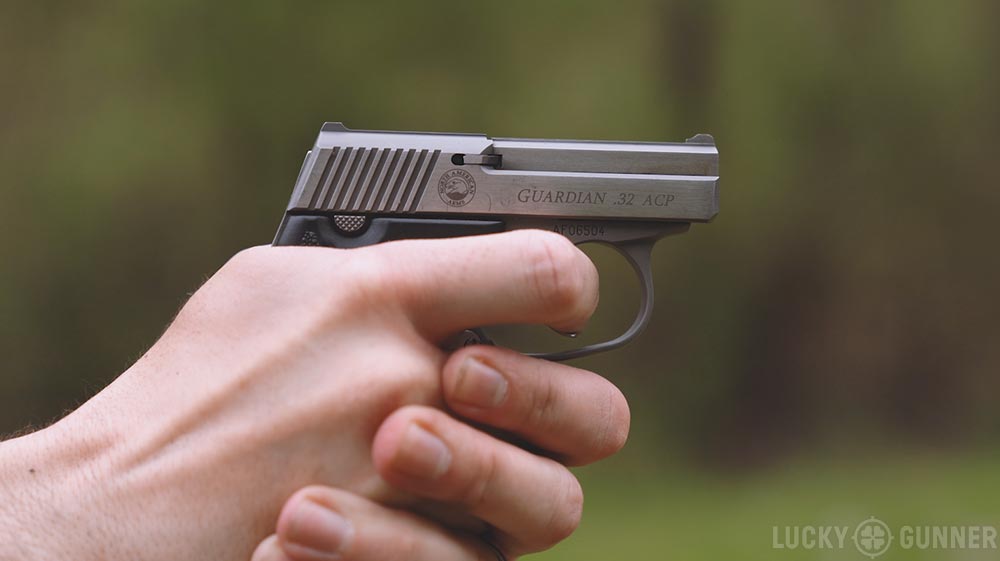
KelTec P32
The Kel-Tec P32 is the lightest of the .32s. It actually may be the lightest semi-auto pistol in current production. It’s seven ounces empty and ten ounces fully loaded with eight rounds. It’s not necessarily the smallest in every outer dimension but it’s certainly among the smallest pistols around. I know Kel-Tec has developed a well-earned reputation for producing problematic firearms. But if there is any exception to that, it’s the P32. They’ve been in production since 1999 which makes it one of Kel-Tec’s oldest designs and I think they have worked out most of the kinks by now. I’ve got about 700 rounds through this one, which is a fairly high round count by pocket pistol standards and I’ve been pretty impressed with how reliable it’s been. It doesn’t run 100% with every type of ammo I’ve tried, but it seems to run just fine with Federal American Eagle and S&B full metal jacket loads.
The trigger pull on the P32 is fairly long, but it’s light at about seven pounds. The grip texture is very aggressive. I’ve got this Pachmayr grip sleeve on here that helps with that and it also fills my hand a little better and makes it easier to get a firm grip on the gun. This belt clip here is another aftermarket add-on. It makes it possible to carry the gun without a holster. One more option I like is the factory extended 10-round magazine. It gives the gun a full size grip that’s easier to draw if you want a very light gun, but don’t necessarily need the smallest possible footprint.
The weakest feature of the P32 is the sights. They are small and very difficult to see. You get a little nub here in front and a tiny notch in the rear. I blacked out all of this rear portion and put some orange nail polish on the front so I can actually see the sights. Fortunately, for me, this gun points really naturally so the sights tend to be more or less aligned when I bring it up to eye-level. If that doesn’t work for you, Crimson Trace does make a laser guard for this gun. So even though it’s far from ideal, if I was looking for the smallest and lightest carry gun possible that I could still shoot reasonably well, I’d probably carry the P32.
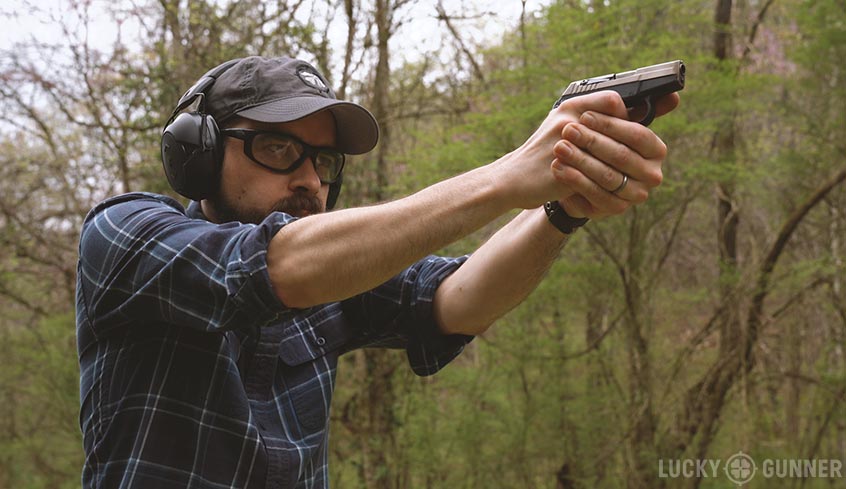
.32 ACP Rim lock
One more thing to look out for is the rim lock issue, but this is something that can happen with any pistol in this caliber. .32 ACP is considered a semi-rimmed cartridge, which means that the diameter of the rim is slightly wider than the case body. So in the magazine, the cartridges are supposed to sit on top of each other like this so that the rim of one case sits in the recess of the case below it. But if the first round on top gets behind the next round in the mag, that first round will get hung up by it’s rim and the gun will not cycle until you take out the magazine and fix it. I set up a rim lock in this mag and if I try to chamber a round, the slide will not close because this top round is essentially locked in place.
Generally, you can avoid this just by loading your magazines carefully. And with full metal jacket ammo, I have found it almost impossible to set up a rim lock in the Kel-Tec, even on purpose. But with hollow point ammo, there’s some extra room in the magazine from front to back and that makes a rim lock malfunction a lot more likely. So that’s just one of the reasons why, if I was going to carry this pistol, or any .32, I would probably load it with full metal jacket ammo.
Between the rim lock issue, the meager selection of pistols, and the supposedly weaker ballistics, the .32 ACP is not looking too good so far compared to a pocket .380. You do tend to get one or two more rounds of ammo capacity in a .32, but the real advantage I haven’t really addressed yet is the reduced recoil. So, is there enough of a difference in recoil between a .32 and a .380 to have a significant impact on how well I can shoot them?
.32 ACP at the Range
To find out, I did some side-by-side testing at the range with a Smith & Wesson Bodyguard, which I tend to shoot better than most of the other pocket .380s. Once again, I decided to use the 5×5 Drill as a way to measure performance. That’s five shots at five yards into a five-inch circle in under five seconds from a low ready position. The Kel-Tec was definitely more pleasant to shoot, but timers don’t lie. With the Kel-Tec P32, my average time out of five runs was 2.12 seconds. With the Bodyguard .380, I averaged 2.3 seconds. So there is a difference, but it’s not what I would call a significant difference.
But that’s just for me. For someone who is inexperienced or not a very skilled shooter or someone who is recoil sensitive in general, the .32 would probably offer a much greater advantage. Those little .380s really are quite a handful. People talk about lightweight J-frame .38s being difficult to shoot well and not good for beginners, but I don’t think an LCP or a Bodyguard is a whole lot easier to manage. A small .32 at least has the potential to make that learning curve quite a bit easier.
.32 ACP Ballistics
But of course, a lot of people are most concerned about the perceived lack of power of the .32 ACP compared to the alternatives. Unfortunately, just like we ran into when I covered .32 caliber revolvers, there is just not much data on how .32 ACP performs in real-world defensive shootings. So again, let’s take a look at some ballistic gel to give us a rough idea of what this round is capable of. This is just a quick, informal test, we will be doing more testing of .32 ACP later on at the end of this series along with all the other pocket pistol calibers.
Staring with a couple of rounds of Speer Gold Dot, the average penetration depth was almost 11 inches. That’s a little less than we’d like to see and there was no expansion. That’s not really a surprise, though. With small caliber hollow points, you typically get either good penetration or good expansion. Sometimes, like in this case, you get neither. They just don’t have enough energy to expand and penetrate. Full metal jacket rounds are often recommended for mouse gun calibers because they at least have a decent chance of penetrating.
So the next load we tried was Federal American Eagle full metal jacket. The first round stopped at 15.5 inches and the second made it all the way to 20 inches. Technically, that’s over penetration, but with the smaller calibers, the reality is that the bullet is most likely going to lose all of its energy by the time it exits the target, so shoot-throughs are not a real concern. We tried one more jacketed hollow point, this one from PMC. Again, there was no expansion, but the penetration was a little better than the Gold Dot with an average of 13 inches. That’s deeper than the ideal 12-inch minimum that we’re looking for, but I still think I’d prefer a full metal jacket in this caliber, especially considering the rim lock issue with the hollow points. A round nose FMJ is not crushing a lot of tissue like we see in the wound channel of a good penetrating hollow point, but that’s just a compromise you have to accept if you’re going to carry a small caliber pistol.
Let’s take a look at how these numbers compare to a few of the .380 loads from our tests a couple of years ago. Those tests were done with a Glock 42, which has a longer barrel than the KelTec so it’s not a totally even comparison. The Gold Dot in .380 had the same kind of shallow expansion as the .32 Gold Dot except that it did expand. The Hornady Critical Defense was really the only .380 that had decent expansion and penetration, but some of the tests I’ve seen with that load from shorter barrels were not so great. So if your gun launches those .380 hollow points with enough velocity to make them penetrate and expand, the .380 might have a bit of a ballistic advantage. On the other hand, if you’re following the advice to carry FMJ ammo in a pocket pistol, it doesn’t seem like there is much difference between a .380 and a .32.
So overall, my take on .32 ACP is that it has potential and it’s really a shame that we don’t have more options for both guns and ammo in this caliber. There might be 100 .380s being sold for every one .32, but at Lucky Gunner, the gap between these two calibers is not nearly as wide in terms of ammo sales. We sell about one round of .32 for every eleven or twelve rounds of .380. Now, that’s not proof of anything, but it does suggest that there are lot of people out there buying these little pocket .380s but not shooting them. They are guns that require a lot of practice to master and for the most part, people are not actually practicing with them because they’re uncomfortable to shoot. If all of those .380s were .32s instead, I think more people would be getting trigger time with their carry guns.
